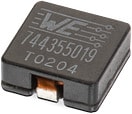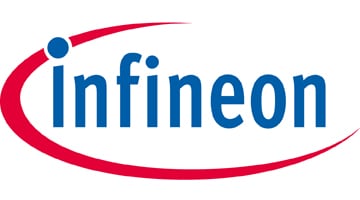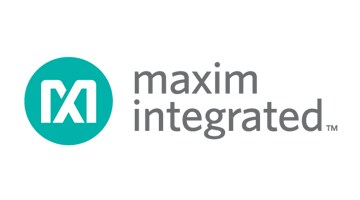Analog Devices LT3743EUF | Demoboard DC1470A
LT3743EUF Demo Board | High Current Step-Down LED Driver Controller, 6.5V ≤ VIN ≤ 24V, VLED = 6V @ 20A
Details
| Topologie | Abwärtswandler |
| Eingangsspannung | 6-36 V |
| Schaltfrequenz | 400-460 kHz |
| Ausgang 1 | 4.5 V / 20 A |
| IC-Revision | 3 |
Beschreibung
Demonstration circuit 1470 is a High Current Synchronous Step-Down LED Driver with Three-State Control featuring the LT3743EUFD. The demo board is optimized for 20A output from a 12V input. Being an LED driver,the output current is being regulated until the output voltage reaches a programmed voltage limit. This voltage limit on this demo board is set to around 6V by R5 and R6. The 6V is chosen because of the 6.3V voltage rating of the output capacitors. The ideal load to be used with this demo board is a single LED, such as PT120 from Luminus Devices. Smaller LEDs may not be able to handle the high current, even for a short period of time. At20A, the demo circuit can operate continuously. However , it is necessary to mount the LED load on a proper heat sink and possibly with a fan to avoid exceed its maximum temperate rating. Note: the demo board 1470 will drive a LED with its cathode grounded. Grounding cathode of the LED allows customers to use positive input supply.
The input voltage range of the LT3743 itself is 6V to 36V.However, the demo board utilizes 30V Mosfets to demonstrate best efficiency so the maximum recommended input voltage is 24V for the demo board. When input isabove 20V during PWM dimming, a slightly larger inductance may be needed. The typical efficiency of the demo board is 94% from a 12V input to 5V, 20A load. The lower the input voltage, the higher the efficiency tends tobe with a given load. At output power level of 100W, a couple of percent of efficiency improvement is a huge advantage in minimizing temperature rise. If an efficiency measurement is needed in an application, the output voltage must be measured at the output capacitors instead of at the LED load. This prevents cable loss from being counted as a loss of the board. If efficiency measurement is required during PWM dimming, the average current and voltage values should be measured with proper equipments. All LT3743 circuits turn off unnecessary circuits during PWM off period to minimize power losses. As a result, efficiency in many PWM dimming applications is almost the same as efficiency of the constant current applications.
The demo circuit DC1470A uses a split output capacitor configuration to achieve <2us current rise time from 0A to 20A. To see the real rise time, connecting wires between the LED and the board should be minimized to no more than 2 inches total to minimize the wire inductance.1 inch is even better. The cathode of the LED should returnto LED- with R25 populated with a resistor in a few m=. It is recommended to measure the voltage on R25 with a short 50= coax cable directly into a BNC connector on the oscilloscope. The current can then be calculatedfrom the measured voltage. To get accurate current , R25 should be measured before it is mounted on the board. A current probe adds more delays to the rise time so using a current probe is not recommended. Iffast rise time measurement is not necessary, the cathode of the LED can be connected to GND as shown in Figure 1.
R27 can be used to slow down the gate drive. Slower gate drive helps to reduce ringing on the SW node without noticeable effect on the efficiency. A 10= is usually more then enough to completely damp any ringing.
R15, R16 and C15 help filtering out voltage spikes seen on the SENSE+ or SENSE- pin. It is critical to have those components on a board.
LT3743 has a three-state control. It can change output current among zero, a low level and a high level, all in a few us. The low current level of the demo board is set to around 5A. The high current level is 20A. Both levels can be adjusted by changing the voltage dividers on CTRL_H and CTRL_L. Applying a PWM signal to CTRL_SEL will toggle the output between 5A to 20A. While applying a PWM signal to the PWM pin will toggle the output betweeneither 0 to 5A or 0 to 20A depending on the CTRL_SEL level.
The LT3743 datasheet gives a complete description of the part, operation and application information. The datasheet must be read in conjunction with this quick start guide for demo circuit 1470A.
Weiterführende Informationen
Artikeldaten
| Artikel Nr. | Datenblatt | Simulation | Downloads | Produktserie | L (µH) | IRP,40K (A) | ISAT1 (A) | ISAT,30% (A) | RDC (mΩ) | fres (MHz) | Material | Muster | |
|---|---|---|---|---|---|---|---|---|---|---|---|---|---|
 | 7443551130 | SPEC | 8 Dateien | WE-HCI SMT-Hochstrominduktivität | 1.3 | 32.1 | 11 | 25 | 1.8 | 59 | WE-PERM |
| Artikel Nr. | Datenblatt | Simulation | |
|---|---|---|---|
 | 7443551130 | SPEC |
| Muster |
|---|
| Artikel Nr. | Datenblatt | Simulation | Downloads | Produktserie | L (µH) | IRP,40K (A) | ISAT1 (A) | ISAT,30% (A) | RDC (mΩ) | fres (MHz) | Material | Muster |
|---|







